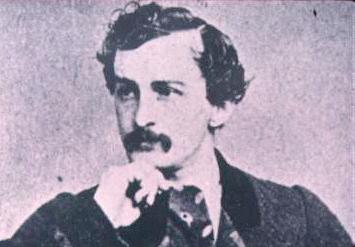
Hood County Texas Genealogical Society
BOOTH LEGEND SPANS THE YEARS
Reprinted from Hood County News Centennial Edition
September 23, 1971

JOHN WILKES BOOTH
An article titled "New Light on a Famous Tragedy" from the 1929 edition of the Granbury News, states "If it is true that the shot fired near Concord bridge in Massachusetts one morning in April 1775 was "heard around the world", then it is equally true a shot fired in Ford's Theater in Washington, D.C. one evening in April 90 years later seems to echo down through history for all the years to come. So the tragedy of the assassination of Abraham Lincoln by John Wilkes Booth has a sorrowful fascination about it which makes it unforgettable." The story was written by Elmo Scott Watson and further states that reports from several sources concerning Booth's allegeded [sic] escape from the burning barn was untrue. "For the truth is, John Wilkes Booth died in the burning barn, probably by his own hand, and all who later claimed to be the assassin were rank imposters," states Watson.
Many people of Granbury and Hood County have believed through the years that he did indeed escape to Texas under the name John Saint Helen. There is much evidence from many unrelated sources which lends support to the story.
Following the assassination, Booth broke his left leg while escaping Fords Theater. There was some question as to whether or not the man killed later and buried as Booth was actually him. The Hood County History Book states "On the charitable side it can be said that St. Helen was an odd acting sort. Whenever he felt he was in danger of being discovered, he disappeared farther into the wilderness." There was only one time when John St. Helen claimed to have assassinated the President. This was when he thought himself to be dying, and made the confession to some friends and a priest. However, he made a recovery from his illness but those people who heard his confession never forgot it.
St. Helen was said to have lived in Glen Rose for a period of time.
Frank McCoy recalled that St. Helen operated a small store near Barnard Mill. Men who worked on that mill were his customers. During this time, a man named Thomas Jordon was running the mill, and his sister was engaged to marry a man from Paris, Texas. When the man came to Glen Rose for the wedding, John St. Helen disappeared. He had learned that the man from Paris was a United States Marshall. People say he traveled very light, as would a man running from the law. He lived in a log house near Wheeler Branch, and all his possessions were left there. The History Book further states: "Many historians agree on the possibility of a carefully planned plot to kill Lincoln, involving high cabinet officials, notably War Secretary Edwin McMaster Stanton. In fact, some historians are convinced actor Booth played only a supporting role." History reports that positive identification was never made and one witness said the right leg, not the left, was broken on the dead man said to have been Booth. This lends more support to the story of St. Helen.
Many residents of Granbury have given facts on this story through the years, and Miss Mittie Aiken, who lived in Granbury all her life said her mother, Mrs. Ed Aiken was acquainted with St. Helen when she was young. This would make the time around 1870. She said he was very handsome, and walked with a limp, favoring his left leg. He came to Granbury to visit a cousin, Mrs. Fannie Rhea, whose maiden name was Booth, according to records. It is said she was asked not to reveal the man's real name.
While in Granbury, he worked as bartender for F.J. Gordon and also rode horses for Gordon who had a race tract on what is now the Black Ranch. It was at this time St. Helen became ill and Gordon sent for a priest. He stated then that he was John Wilkes Booth and where to find the gun he had used in the assassination. He said the gun was hidden in a house which stood at what is now the corner of East Bridge Street and North Cleburne Streets in Granbury. Mr. Gordon found the gun, wrapped in a chamois belt with pouches, which resembled a money belt. All were wrapped in a newspaper which told of the assassination of Lincoln.
When St. Helen recovered from his illness, he again disappeared from Granbury. His deathbed confession soon spread over the county and in 1903, a man in Enid, Okla. claimed before committing [suicide he was] Lincoln's assassin. Finis Bates had the body numified [sic] and took it over the country showing it as the "true assassin of Lincoln." However, when the body was shown in Granbury, both St. Helen's cousin, Fannie Rhea and Mr. Gordon said it was not the same man who had lived here.
So, as years go by, historians continue to research this and other theories about Lincoln's assassination. Perhaps the real truth will never be known.
Web Page by Virginia Hale